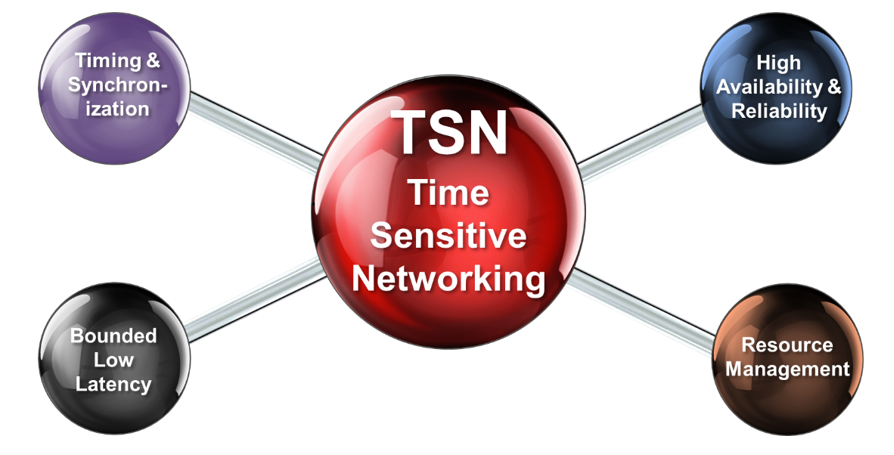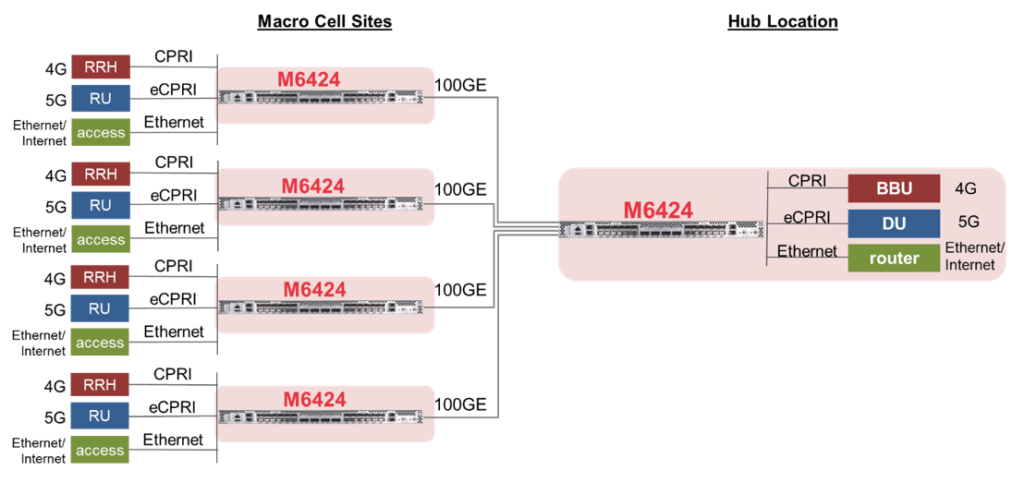
Service providers are rapidly transforming their networks to deliver competitive and affordable 5G services, and cell site densification is one of the key factors in the eventual success of 5G. But deploying fiber and then maximizing bandwidth capacity to so many cell sites can be an expensive proposition. Compared to active WDM-based offerings, Ethernet-based mobile fronthaul using Time Sensitive Networking (TSN) can significantly reduce the total cost of ownership, with up to 50% lower capital costs, 90% turn-up time savings, 75% footprint reduction, and simplified spares and inventory management.
Time-Sensitive Networking
Standards have been developed that are crucial to the success of mobile fronthaul. The IEEE 802.1 Time-Sensitive Networking set of standards extends Ethernet to support time-sensitive traffic, with stringent bounds on loss, end-to-end delay (latency), and delay variation (jitter). This standard is intended to combine the deterministic performance and reliability of circuit-switched technologies with the speed and scale of Ethernet. In this blog, we dive into TSN as well as IEEE 802.1CM, the TSN profile for mobile fronthaul.
Four key components of TSN serve to support real-time communications:
1. Timing and synchronization
2. Bounded low latency
3. High availability and reliability
4. Resource management

Timing and Synchronization
The 5G RAN requires greater timing accuracy and precision than 4G. Another difference with 4G is that the remote radio heads (RRH) will more likely derive timing from the network, instead of from a GPS clock located at the cell site (a more expensive option). Hence the timing network needs to be planned properly, the number of hops between the clock and the radios minimized, and the time error introduced at each hop minimized. Amongst other considerations, the required fronthaul and associated midhaul/backhaul networks’ timing accuracy and latency tolerance will depend on the 5G RAN functional splits that includes CPRI and eCPRI architectures.
The IEEE 1588v2 Precision Time Protocol (PTP) is used to provide timing and synchronization to the 5G radio unit (RU). Ethernet switches in a TSN network act as telecom boundary clocks (T-BC), processing and passing on timing information, correcting errors, and synchronizing traffic accordingly. TSN networks use the IEEE 802.1AS timing protocol, which is a subset of PTP with additions.
Bounded Low Latency
An Ethernet-based mobile fronthaul network will likely transport multiple traffic types:
- CPRI, which is encapsulated with Ethernet using IEEE 1914.3 Radio over Ethernet
- eCPRI, which is already packet-based, from 5G RU to the DU/CU
- Alarms, environmental monitoring, and operations data from the cell site to the NOC
- Converged service offerings, such as business Ethernet services
Within these traffic types, TSN implements a variety of quality of service (QoS) mechanisms at the switch level to deliver the zero congestion loss, deterministic latency, and minimal jitter required:
| Credit-based shaper IEEE 802.1Qav | Smooths out packet transmissions; reduces bursting and bunching. A similar algorithm is used in Carrier Ethernet networks. |
| Frame Pre-emption IEEE 802.1Qbu IEEE 802.3br | Critical, express frames can interrupt transmission of lower priority frames. Pre-empted frames are not lost. |
| Time-Aware Shaper (TAS) IEEE 802.1Qbv | Implements fixed time slices with 8 traffic priorities, the highest for time-critical control data (with a worst-case latency of 100 µs over 5 hops). |
| Cyclic Queuing and Forwarding (CQF) IEEE 802.1Qch | The use of double buffers synchronizes transmissions in a cyclic manner, resulting in bounded latency that is independent of the network topology. |
| Asynchronous Traffic Shaping (ATS) IEEE 802.1Qcr | Improves link utilization for mixed traffic types. The techniques above handle deterministic traffic very well, but are less efficient for traffic with arbitrary profiles. ATS remedies this. |
In addition to these standards, IEEE 802.1CM includes standard TSN profiles for fronthaul that enable the transport of fronthaul streams, specifically with regards to:
- CPRI, eCPRI use cases, requirements, and synchronization, as well as the RBS (Radio Base Station) splits
- Packet networking and synchronization characterizations for Bridging and TSN features
- Leveraging the telecom profile of IEEE 1588v2
The result is two 802.1CM profiles that apply to both CPRI and eCPRI, and meets the requirements of TSN for fronthaul:
- Profile A: Simple and based on the strict priority of CPRI and eCPRI traffic
- Profile B: Leverages frame pre-emption (IEEE 802.3br & 802.1Qbu) to maintain strict priority traffic with pre-emptible Ethernet traffic
High Availability and Reliability
A robust network must cope with power outages, switch failures and fiber cuts. But Ethernet networks are bridged packet networks, not fault tolerant SONET/STM rings. Thus several network level mechanisms have been built into TSN to ensure end-to-end availability and reliability:
| Frame Replications and Elimination for Reliability (FRER) IEEE 802.1QCB | Duplicate copies of each frame are transmitted over separate paths across the network, and 1+1 or 1+N redundancy is possible. At the other end, the packets are merged and/or discarded. Note that this does not rely on link failure detection or switchover, as in the case of SONET, but rather on duplicating packets. |
| Path Control and Reservation (PCR) IEEE 802.1Qbu | Configures multiple paths through the network for frame replication. Multiple paths in Ethernet networks are usually avoided in order to prevent bridging loops. |
| Per-Stream Filtering and Policing (PSFP) IEEE 802.1Qci | Prevents traffic overloads that may stem from bandwidth violations, malfunctions or malicious attacks such as Denial of Service (DoS). |
Operating at a network level, these protocols lend themselves to a software-defined networking (SDN) approach, with a centralized network controller controlling the TSN switches.
Resource Management
The concept of paths across the network is analogous to traditional connection-oriented circuits, and TSN enables centralized network management of paths and devices:
| Stream Reservation Protocol (SRP) IEEE 802.1Qat | SRP provides end-to-end management of traffic streams, allocating the bandwidth resources required at each switch, calculates worst-case latency, and monitors stream metrics. |
| SRP Enhancements IEEE 802.1Qcc | Improves the Stream Reservation Protocol for administration of large TSN networks with improvements to centralized reservation and scheduling, remote management, and reservation requests. |
| YANG data model IEEE P802.1Qcp | Network management, device configuration, and status reporting of switches. |
Putting It All Together: Introducing the HFR flexiHaul™ M6424
The M6424 is an optimized, TSN switch for fronthaul that can be deployed at cell sites, hub sites, and central offices, for aggregating 4G CPRI, 5G eCPRI, and Ethernet traffic onto the transport network. This single aggregation switch offers relief from fiber exhaustion, with no WDM optics required, simplifying deployment and reducing costs.
The M6424 supports the IEEE 802.1CM profiles for fronthaul with frame pre-emption, and is packed inside a 1RU hardened chassis.
